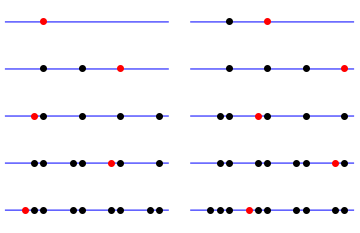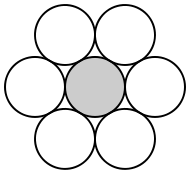This is another gem from the book “Geometric Discrepancy: an Illustrated Guide” by Matousek.
A sequence  is uniformly distributed over
is uniformly distributed over ![[0,1]](https://s0.wp.com/latex.php?latex=%5B0%2C1%5D&bg=fff&fg=444444&s=0&c=20201002) if for each interval
if for each interval ![[a,b) \subset [0,1]](https://s0.wp.com/latex.php?latex=%5Ba%2Cb%29+%5Csubset+%5B0%2C1%5D&bg=fff&fg=444444&s=0&c=20201002) ,
,
 . How does a uniformly distributed sequence over the unit interval look like?
. How does a uniformly distributed sequence over the unit interval look like?
The definition of uniformly distributed sequence is a very natural generalization of the problem of approximating uniform distribution in 1-dimension with finitely many points: suppose we want to place  points uniformly over
points uniformly over ![[0,1]](https://s0.wp.com/latex.php?latex=%5B0%2C1%5D&bg=fff&fg=444444&s=0&c=20201002) , the most natural approach is to place the
, the most natural approach is to place the  points equidistantly over the unit interval. For a sequence of infinitely many numbers, we would like them to sweep “uniformly” over the interval. Note that for a fixed
points equidistantly over the unit interval. For a sequence of infinitely many numbers, we would like them to sweep “uniformly” over the interval. Note that for a fixed  , if we randomly pick
, if we randomly pick  numbers randomly and uniformly from
numbers randomly and uniformly from ![[0,1]](https://s0.wp.com/latex.php?latex=%5B0%2C1%5D&bg=fff&fg=444444&s=0&c=20201002) , the percentage of points falling in the interval
, the percentage of points falling in the interval  is
is  .
.
Weyl’s criterion is the following: for each irrational number  , the sequence
, the sequence  , where
, where  is the fractional part of
is the fractional part of  , denoted by
, denoted by  (
( is the fractional part of
is the fractional part of  ), is uniformly distributed over
), is uniformly distributed over ![[0,1]](https://s0.wp.com/latex.php?latex=%5B0%2C1%5D&bg=fff&fg=444444&s=0&c=20201002) .
.
The following is en example when the irrational number is set to  .
.

The proof is surprisingly short:
First, one can show that for each function  , where
, where  is the imaginary unit,
is the imaginary unit,  , we have
, we have
 : The nice thing is that
: The nice thing is that  equals to
equals to  — the fractional operator
— the fractional operator  disappears because
disappears because  is 1 for any integer
is 1 for any integer  . Therefore, we can compute
. Therefore, we can compute  easily, it is simply
easily, it is simply  , which is nothing but a geometric sum
, which is nothing but a geometric sum  , which is
, which is  . Since
. Since  is irrational,
is irrational,  is never 1, hence the denominator is nonzero. The magnitude of
is never 1, hence the denominator is nonzero. The magnitude of  is upper bounded by
is upper bounded by  , as the magnitude of
, as the magnitude of  is 1. Therefore,
is 1. Therefore,
 .
.
Since  , we have
, we have
 . In particular, this implies that for all trigonometric polynomials
. In particular, this implies that for all trigonometric polynomials  , where
, where  are real numbers, it holds that
are real numbers, it holds that
 . Using Weierstrass’ approximation theorem, one can show that the equation holds for all functions
. Using Weierstrass’ approximation theorem, one can show that the equation holds for all functions  , where
, where  for
for  and 0 otherwise,
and 0 otherwise, ![a, b \in [0,1]](https://s0.wp.com/latex.php?latex=a%2C+b+%5Cin+%5B0%2C1%5D&bg=fff&fg=444444&s=0&c=20201002) –this is precisely the requirement for
–this is precisely the requirement for  being uniformly distributed over
being uniformly distributed over ![[0,1]](https://s0.wp.com/latex.php?latex=%5B0%2C1%5D&bg=fff&fg=444444&s=0&c=20201002) .
.
The Mathematica code to visualize  :
:
pts = Table[
Map[Point[{#, 0}] &,
FractionalPart /@ N[Table[i Sqrt[5], {i, 1, j}]]] /. {x___,
y_} :> {{PointSize[Large], x}, {PointSize[Large], Red, y}} //
Graphics, {j, 1, 10}];
unitinterval =
Graphics[{Blue, Line[{{0, 0}, {1, 0}}]}, AspectRatio -> 1/4];
GraphicsGrid[Partition[Map[Show[unitinterval, #] &, pts], 2]]

